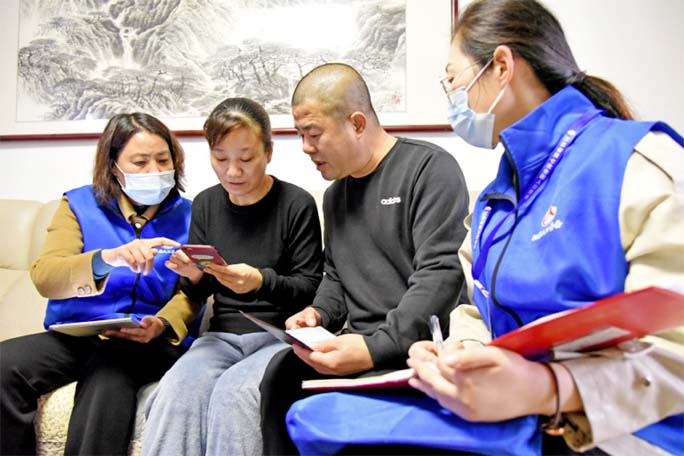
Al Jazeera News :
Millions of census-takers have begun knocking on doors across China for a once-a-decade headcount of the world’s largest population, which for the first time will use mobile apps to help crunch the massive numbers.
About seven million community workers and volunteers will carry out the two-month data-collection effort, visiting homes ranging from residential skyscrapers in downtown Shanghai to remote Tibetan mountain villages.
China conducts the census every 10 years to determine population growth, movement patterns, and other trends, using the findings to apportion resources for education, health, transportation, labour, elderly care and other services.
The previous tally in 2010 counted 1,339,724,852 – an increase of 5.83 percent, or 73,899,804 people – equal to adding more than the population of France over 10 years.
Much of the attention on this year’s census – expected to take two years to fully compile – will focus on whether it indicates any population bump from China’s relaxation of its former “one-child policy”.
The policy was introduced in the late 1970s to slow rapid population growth amid concerns over too many mouths to feed, but it was relaxed four years ago to allow couples to have two children in the midst of fears over China’s fast-ageing society and shrinking workforce.
But the change has not yet resulted in a baby boom.
The national birth rate last year was the slowest since the founding of Communist-ruled China in 1949, with many Chinese today choosing smaller families amid rising living costs.
The government estimates the 2020 census could update the population to 1.42 billion, a 5.99-percent increase.
A research institute affiliated with real estate giant Evergrande Group last week issued a study saying the government figure was an overestimate and recommended three children be allowed.
“If adjustments are not made, it will seriously affect national rejuvenation and [China’s] rise as a great power,” the researchers said, citing two of the stated goals of President Xi Jinping.
The study sparked a passionate online discussion with many saying the real curbs on childbirth are rising costs and insufficient policy support for families.
“If we had a kid we wouldn’t have enough time for [doing] the things we enjoy,” Fan Shaoyou, a Chinese civil servant told Al Jazeera.
“There would be too much pressure as the cost of living in China is rising, and the pace of work and life is very fast these days,” he added.
Demographic experts have estimated it could take 15 years for the two-child policy to have any noticeable effect as other modern factors mitigate rapid growth, including increasingly empowered Chinese women delaying or avoiding childbirth, and the slower population growth that comes with rising national affluence.
Despite the door-to-door visits, most citizens are expected to enter their information via a smartphone app, adding to rising concerns about privacy protection.
Millions of census-takers have begun knocking on doors across China for a once-a-decade headcount of the world’s largest population, which for the first time will use mobile apps to help crunch the massive numbers.
About seven million community workers and volunteers will carry out the two-month data-collection effort, visiting homes ranging from residential skyscrapers in downtown Shanghai to remote Tibetan mountain villages.
China conducts the census every 10 years to determine population growth, movement patterns, and other trends, using the findings to apportion resources for education, health, transportation, labour, elderly care and other services.
The previous tally in 2010 counted 1,339,724,852 – an increase of 5.83 percent, or 73,899,804 people – equal to adding more than the population of France over 10 years.
Much of the attention on this year’s census – expected to take two years to fully compile – will focus on whether it indicates any population bump from China’s relaxation of its former “one-child policy”.
The policy was introduced in the late 1970s to slow rapid population growth amid concerns over too many mouths to feed, but it was relaxed four years ago to allow couples to have two children in the midst of fears over China’s fast-ageing society and shrinking workforce.
But the change has not yet resulted in a baby boom.
The national birth rate last year was the slowest since the founding of Communist-ruled China in 1949, with many Chinese today choosing smaller families amid rising living costs.
The government estimates the 2020 census could update the population to 1.42 billion, a 5.99-percent increase.
A research institute affiliated with real estate giant Evergrande Group last week issued a study saying the government figure was an overestimate and recommended three children be allowed.
“If adjustments are not made, it will seriously affect national rejuvenation and [China’s] rise as a great power,” the researchers said, citing two of the stated goals of President Xi Jinping.
The study sparked a passionate online discussion with many saying the real curbs on childbirth are rising costs and insufficient policy support for families.
“If we had a kid we wouldn’t have enough time for [doing] the things we enjoy,” Fan Shaoyou, a Chinese civil servant told Al Jazeera.
“There would be too much pressure as the cost of living in China is rising, and the pace of work and life is very fast these days,” he added.
Demographic experts have estimated it could take 15 years for the two-child policy to have any noticeable effect as other modern factors mitigate rapid growth, including increasingly empowered Chinese women delaying or avoiding childbirth, and the slower population growth that comes with rising national affluence.
Despite the door-to-door visits, most citizens are expected to enter their information via a smartphone app, adding to rising concerns about privacy protection.

